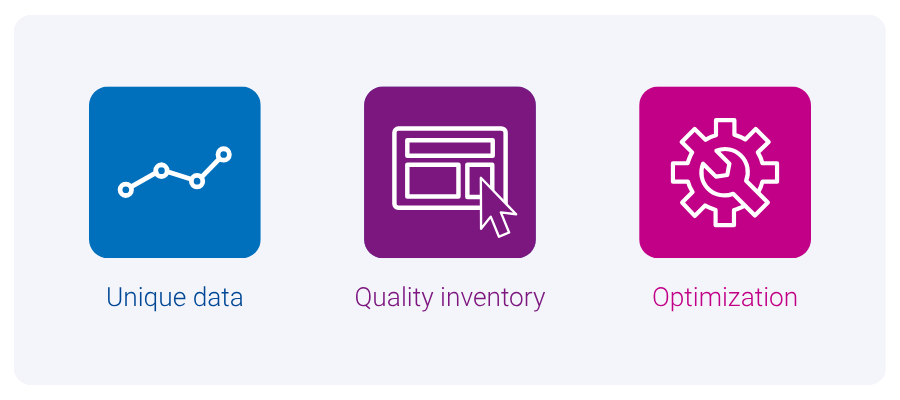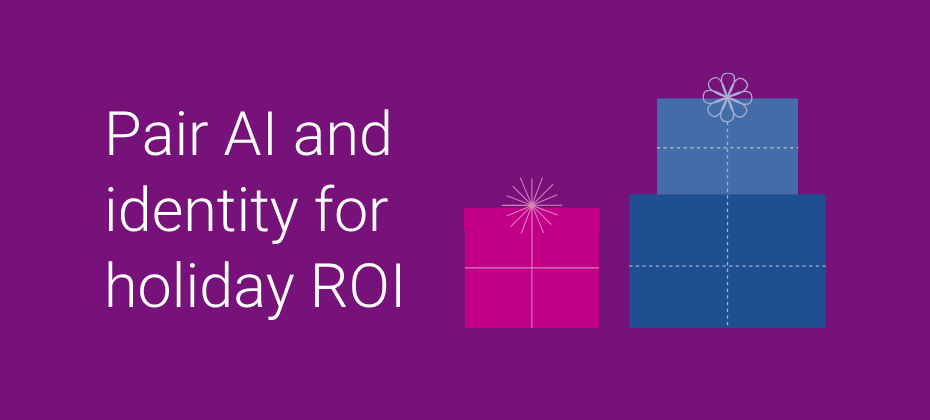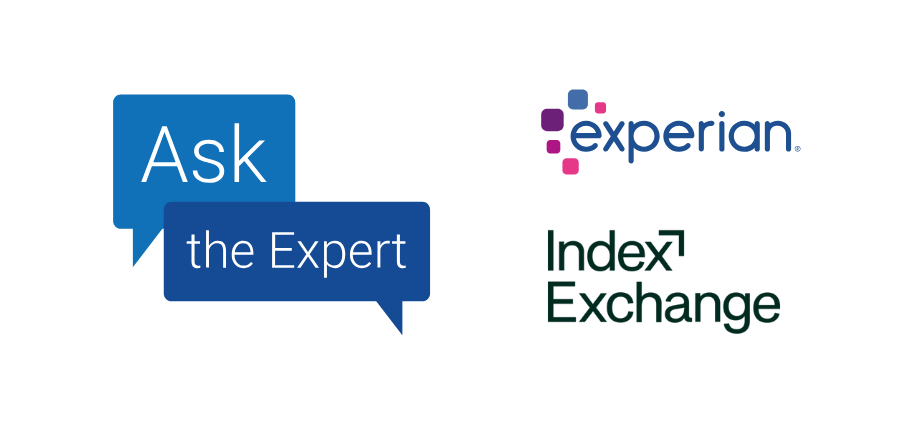At A Glance
Curation is changing how media is bought and sold, moving beyond open auctions and static site lists to more efficient deals. By combining unique data, real-time supply connections, and continuous optimization, curated PMPs reduce waste and improve results. Audigent's, a part of Experian, solutions help marketers achieve measurable outcomes with curated strategies that deliver better targeting, higher engagement, and improved ROI.If you buy media today, you’re already feeling the shift: the best results don’t always come from broad, open auctions or static “safe site” lists; they’re coming from deals that combine the right data with the right inventory and let algorithms optimize in real time. That’s curation. And when it’s done right, it reduces data and media waste for buyers and raises eCPMs (effective cost per thousand impressions) and win rates for publishers.

As part of our Cannes Content Studio series, leaders from Butler/Till, Index Exchange, OpenX, PubMatic, and Yieldmo discuss how curation cuts waste and lifts results.
What is real curation?
Real curation isn’t “packaging inventory.” It’s a strategic framework built on three pillars:
Why it matters: Manual approaches hit a ceiling. They can’t react quickly to shifting content, identity signals, or auction dynamics. That’s where technology partners come in, keeping the optimization loop running continuously.
Intelligence at every touchpoint
Curation isn’t about shifting control between platforms. It’s about better brand decisions, connecting opportunity-rich supply to the brand’s preferred buying platform and enriching each buy with audience data.In practice, supply-side platforms (SSPs) are ingesting richer signals to route inventory more effectively and support frequency caps and deal prioritization, in collaboration with demand-side platforms (DSPs).
“I think we’re seeing a shift toward bringing more DSP capabilities into the SSP, like supply-side targeting and data driven curation. Advancements in areas like CTV are enabling targeting based on content signals, and SSPs are pulling in more data to inform which supply is sent to the DSP, helping with things like frequency caps.”
OpenXMatt Sattel
Why page-level targeting beats static lists
Static domain lists were a useful first step for quality control. The intent was sound, but the approach was too cumbersome for today’s signal-rich buying. Today, AI and contextual engines read the page, not just the site, and adapt in real time.

Page-level logic delivers three key benefits:
- Accuracy by targeting high-intent, page-level content.
- Relevance by matching the creative to both the content and the audience context.
- Speed by enabling campaigns to move away from underperforming pages in real time, without waiting for a manual trafficking change.
“AI-driven contextual engines evaluate the page, not just the domain, to curate inventory in real time. That moves curation from static allowlists to adaptive logic for greater accuracy, relevance, and speed.”
YieldmoSophia Su
Partnerships broaden who influences the buy

Curation works when publishers, agencies, data partners, and platforms share signals and KPIs.
- Horizontal curation (across multiple SSPs) assembles broader, higher-quality reach and resilience, ideal for scale and diversity of supply.
- Vertical curation (an SSP’s in-house product) provides deep controls within a single exchange, useful for specific inventory strategies.
- Creative and data now shape supply and demand: better creative decisioning, tested against richer signals, improves outcomes.
DSPs remain central for activation and pacing. But the sell-side’s growing intelligence means more accurate inventory routing and signal application before a bid ever fires.
“Curation will continue to evolve through deeper data partnerships and expanded use across publishers and agencies, with more sophisticated types of optimization. DSPs will remain critical to activation, even as sell-side decisioning plays a larger role in identifying and shaping the supply to select.”
Index ExchangeMike McNeeley
Curation delivers access and measurable performance

Here’s what curated deals are delivering.
For buyers
| Result | Type of result |
| 36-81% | savings on data segments |
| 10-70% | lower cost per click (CPCs) |
| 1.5-3x | higher click-through rates (CTRs) |
| 10-30% | higher video completion rates |
For publishers
| Result | Type of result |
| 20% | bid density |
| 118% | win rate |
| 10% | revenue on discovered inventory |
| 25% | eCRM on incremental impressions |
Why it works: When data, supply, and optimization are integrated, you reduce waste, surface better impressions, and let algorithms compound your advantage. That’s why curated private marketplaces (PMPs) have grown at ~19% compound annual growth rate (CAGR) since 2019.
“Publishers using supply-side curation see ~15% more diverse buyers and 20–25% better performance than buy-side-only targeting. Smarter packaging and signal application tighten auctions and strengthen outcomes.”
PubmaticHoward Luks
Holistic curation streamlines planning and outcomes

Curation adds the data layer earlier in the buying process, starting at the supply-side. This creates more opportunities to reach the right audience and improves scale and performance. By replacing multiple line items with a single curated deal, campaign setup becomes faster and less error-prone. Curated deals also simplify measurement by including the necessary context for accurate attribution, while dynamic adjustments ensure campaigns remain optimized without requiring manual updates.
“Publishers using supply-side curation see ~15% more diverse buyers and 20–25% better performance than buy-side-only targeting. Smarter packaging and signal application tighten auctions and strengthen outcomes.”
Butler/TillGina Whelehan
It’s much more streamlined, bringing more pieces together so we’re thoughtful and holistic. Adding the audience and data element creates more scale and strategy in how we curate supply and data, and ultimately better results for clients.
The bottom line
Curation has matured from buzzword to performance system. DSPs still anchor activation and pacing, but better sell-side pipes now pre-route inventory and apply signals before any bid starts, making the whole system faster and more accurate. When you combine unique signals, tight supply connections, and always-on optimization, you gain addressability, reduce waste, and achieve better business outcomes for both buyers and sellers.
Curation isn’t just a trend; it’s where programmatic advertising is headed. Start testing curated PMPs today to see the difference for yourself.
Explore curated PMPs with Audigent
Curation FAQs
Curation in performance marketing is the process of combining data, inventory, and optimization to deliver better results. Audigent supports curated strategies through privacy-safe data and advanced integrations.
Curation reduces wasted spend by targeting high-quality impressions and optimizing campaigns in real time. Audigent’s solutions help marketers achieve higher click-through rates, lower costs, and better engagement across channels.
Curated PMPs are deals that use curated data and inventory to deliver measurable results. They help buyers save on data costs, improve ad performance, and achieve better video completion rates, while publishers see higher win rates and revenue.
Audigent provides unique data assets, privacy-safe integrations, and optimization tools that help marketers and publishers create curated deals. Our solutions ensure campaigns are more efficient, targeted, and effective from start to finish.
Horizontal curation combines inventory across multiple platforms for broader reach and diversity, while vertical curation focuses on deep control within a single platform. Both approaches can be tailored to specific campaign goals with Audigent’s expertise.
Latest posts

Originally appeared in Adweek This holiday advertising season, identity is the real differentiator Marketers are betting big on AI to run their holiday advertising, using it to build predictive audiences, generate creative at scale, and optimize media buys in real time. The draw is clear: greater efficiency, delivered at scale. But here’s the problem: without a solid identity foundation, AI is just guessing. And in a year when consumers are cautious and competition is fierce, guesses won’t deliver the outcomes you need. Experian’s 2025 Holiday spending trends and insights report shows that success this season will depend on connecting the right data to the right audiences in real time. Download the report now Are shoppers really using AI to make holiday purchases? Not yet. Only 12% of consumers plan to use AI tools to shop this season, mostly for finding discounts. Instead, trusted influences (like retailer websites, product reviews, and recommendations) still guide buying decisions. For marketers, that’s a signal to focus on credibility and connection. AI can support your holiday advertising strategy, but trust still wins the sale. Consumer sentiment heading into the holidays is low, but that could mislead marketers Here's why How marketers are really using AI in holiday advertising Behind the scenes, AI is working overtime. Teams use it to segment audiences, test creative, and optimize media in real time. These capabilities are powerful, but only if they’re grounded in accurate, persistent data. Think about the typical holiday shopper. They may browse a product online, validate it in store, and finally purchase days later from a different device than they used while browsing. If AI isn’t anchored in identity, it struggles to connect those touchpoints. Instead of amplifying relevance, it amplifies noise. See our predictions for Black Friday 2025 Why identity is the GPS for AI-driven holiday advertising Identity is what turns AI from a blunt instrument into an accurate tool. By unifying fragmented signals across channels and devices, identity provides the consistent consumer view that AI needs to be effective. With that foundation, AI can do more than churn out models. Instead, it can: Identify the right audiences and filter out waste Personalize with context, not just scale Measure real outcomes, linking exposures to visits and purchases Identity doesn’t just improve efficiency; it creates accountability. And in a season where every holiday advertising campaign dollar is scrutinized, accountability is the difference between investment and waste. Why connected data will make or break Cyber Week How to turn complexity into clarity this holiday season This year's holiday advertising season is complicated. Marketers are confident, consumers are cautious, and AI is somewhere in the middle. The challenge isn’t just speed or volume, it’s accuracy. By pairing AI with identity, you can adapt to real behavior instead of assumptions. You can build campaigns that are consistent across connected TV, retail media, and social platforms. And you can prove results when it matters most. AI isn’t a holiday miracle. But when it’s powered by identity, it can give you clarity in a noisy season and proof of performance when budgets are under scrutiny. Explore Experian's holiday audiences to activate this season What’s the real takeaway for marketers this season? Don’t assume AI alone will save your holiday advertising strategy. It won’t. Consumers still trust human voices more than machines, and your AI models are only as strong as the data beneath them. Identity is the difference between guesswork and accuracy, between activity and impact. This holiday season, the winners won’t be the brands that simply spend more or automate faster. They’ll be the ones that put identity at the core of their AI strategy and meet consumers where they really are. Download Experian’s 2025 Holiday spending trends and insights report to see where consumers are spending and how identity can help your holiday advertising campaigns more effective. Download now About the author Colleen Dawe VP, Advertiser Partnerships, Experian Colleen Dawe is VP, Advertiser Partnerships at Experian Marketing Services, where she oversees revenue growth and client success, helping advertisers harness data and identity to fuel marketing strategies. With over 15 years of experience spanning TV and digital media, she brings deep expertise in data, identity, activation, and measurement to help her clients connect innovation with business outcomes. Holiday advertising FAQs Why isn’t AI enough on its own for holiday advertising? AI works best when it’s grounded in accurate data. Without identity, it can’t connect actions across devices or channels, which limits its effectiveness. How does identity improve AI-driven campaigns? Identity creates a single, persistent view of your audience. That means AI can personalize content, measure conversions, and cut waste with far greater accuracy. What does “identity” mean in marketing terms? It’s the data layer that connects people across their devices, browsers, and behaviors—so your campaigns reach real individuals. How can marketers prove ROI in holiday advertising? By tying exposure to verified outcomes—like store visits or purchases—using identity-linked data. That’s how Experian helps brands move from impressions to impact. Latest posts

What challenge did the pet brand face? A national e-commerce pet supplier wanted to expand into audio advertising to diversify beyond display campaigns. But with only one team member available to test this new channel, they faced three hurdles: Prove performance in a new channel Run lean with limited bandwidth Show purchase intent, engaged site visits, and completion rates fast They needed a partner to handle execution and supply optimization so their lean team could focus on strategy and selling audio internally. Hear how we're working with Audacy to help our clients connect beyond the screen Tune in here The solution: How did Experian Curated Deals help? Audigent, a part of Experian, ran point on setup, optimization, and real-time reporting. The brand turned to Experian Curated Deals. Together we: Streamlined access to curated inventory, cutting intermediaries and boosting efficiency Handled campaign setup and supply-side optimization Delivered real-time demand-side platform (DSP) reporting for agile targeting refinements Provided an extension of their in-house team, giving them bandwidth to focus on pitching audio internally “What stood out about Experian was their real-time control and the depth of their trading team. I knew I could hand them a campaign, and they’d run with it.”Programmatic Media Lead, National e-commerce pet supplier Want to see the full case study? Download it here What results did the campaign deliver? In just a few months, audio transformed from a small test into a top-performing channel: Exceeded KPIs by 63% Increased purchase intent and engagement vs. competing platforms Matched display performance without creative refreshes or incentive overlays Earned budget increases, positioning audio as a long-term investment Reduced internal setup time, freeing the team for strategic projects “Experian became more than just a media partner: they filled critical gaps that would typically require outsized investment in internal resourcing.”CMO, National e-commerce pet supplier Explore more examples of how brands are driving performance with Experian Windstar Cruises Leading athletic retailer Swiss Sense Why does this matter for marketers? For marketers, audio isn’t experimental anymore. It’s a proven channel that can drive both engagement and conversions. This case study shows how brands can: Use Experian Curated Deals to validate new channels with minimal risk. Lean on Experian to handle execution, freeing teams to focus on growth. Drive meaningful engagement and purchase intent, not just impressions. For marketers navigating limited resources and pressure to prove ROI fast, Experian Curated Deals provides both performance and confidence. Want to beat your campaign goals by double digits? Contact us today Curated Deals FAQs What is Experian Curated Deals? Experian Curated Deals streamline access to premium media inventory by eliminating unnecessary intermediaries, optimizing efficiency, and ensuring campaigns perform against KPIs. Why use curated deals for audio advertising? Curated deals help brands test and validate audio quickly, without the heavy lift of manual setup and supply path management. Can audio really drive conversions? Yes. In this case, audio campaigns not only exceeded awareness and engagement goals but also matched the conversion performance traditionally associated with display. How does Experian support lean teams? By managing setup, supply optimization, and reporting, Experian acts as an extension of your team, reducing internal workload while driving performance. Latest posts

In our Ask the Expert Series, we interview leaders from our partner organizations who are helping lead their brands to new heights in AdTech. Today’s interview is with Paul Zovighian, VP of Marketplaces at Index Exchange. Sell-side activation vs. buy-side packaging What’s fundamentally changed with sell-side decisioning, and how does it now diverge from traditional buy-side packaging? Sell-side decisioning is programmatic’s next major evolution – one that redefines how intelligence enters the transaction. Advances in infrastructure and computing power now allow supply-side platforms(SSPs) to act in the crucial pre-bid moment, enriching impressions with context, quality, and data before they reach the buy side. This isn’t just about efficiency; it’s about unlocking new value. Smarter requests mean buyers see only the most relevant opportunities, while publishers gain recognition for the true worth of their audiences and environments. We’re still at the beginning of this shift. Many players still package inventory without engaging in real pre-bid intelligence. As the market matures, the companies that evolve toward sell-side decisioning will be the ones to set the pace for programmatic’s future. Economic shifts with scaled curation As curation scales, what economic levers shift for both publishers and buyers, and how do those shifts influence deal structure and media planning? As curation scales, one of the most powerful levers is data. It’s the industry’s most valuable asset, and on Index it keeps its full worth. We don’t take a platform cut or add hidden fees, so data partners benefit from the clearest, most efficient economics in the market. Data vendors gain confidence that their economics aren’t eroded by a platform tax. For publishers, this means stronger yield and more ad spend flowing directly into working media. When data retains its full value, it enhances how impressions are packaged, priced, and differentiated—driving more competition for quality inventory and more opportunities for revenue. For buyers, it means compressed supply paths and total transparency – they know exactly what they’re paying for. With no intermediaries and full transparency into economics, buyers gain a clearer view of where their budgets go and the confidence that their investments reach real audiences in trusted environments. They benefit from cleaner supply chains, better performance, and more meaningful alignment between spend and outcome. The result is a healthier marketplace where both sides benefit from efficiency, fairness, and scale. Moving decisions upstream for value What decisions historically made in DSPs should now move upstream to publishers or SSPs to unlock more value, and which should remain buy-side? Decisioning is no longer confined to demand-side platforms(DSPs). We can enrich impressions by applying intelligence — via data, algorithms, creative technology, and more, before they even reach the buy side — adding context, filtering out low-quality supply, and expanding audience discovery. This isn’t about shifting roles; DSPs remain critical for campaign strategy, optimization, and budget allocation. The sell side simply ensures every bid request is smarter from the start, creating more value for all parties. In doing so, we also alleviate pressure on DSPs — enabling more comprehensive data discovery by searching for signals at the top of the funnel, prior to optimization. That means DSPs can focus on what they do best, supported by a cleaner, more transparent supply path. Index Marketplaces use cases explained Index Marketplaces is designed to enable the strength of our partners, and Experian brings one of the broadest sets of demographic and audience insights in the industry. That scale enables a wide variety of applications, from more precise audience activation to deeper measurement and analytics. What’s different on the sell side is how those insights are applied. By activating Experian’s syndicated audiences directly at the point of decision, their value is realized in real time and across the full scale of the open internet. Buyers gain a clearer path to relevant audiences, and publishers benefit from stronger alignment between data and media. It’s an approach that ensures partners like Experian can maximize the impact of their assets while helping the market move toward more intelligent, performance-driven activation. Identity signals with stronger privacy For identity partners like Experian, what’s the right way to bring audience, context, and propensity signals into sell-side activation? The beauty of sell-side decisioning is that it reduces the hops in how identity signals are applied. Without it, IDs have to travel through multiple platforms, creating extra handoffs and additional risks of data loss or leakage. With sell-side decisioning, those signals are obfuscated under a deal ID and applied directly at the point of decision. That means audience, context, and propensity data are activated securely, without ever leaving the sell-side environment. For partners like Experian, it’s the cleanest path to value: fewer hops, stronger privacy protection, and clearer economics for everyone in the chain. Contact us About our expert Paul Zovighian VP of Marketplaces, Index Exchange Paul Zovighian carries over a decade of industry expertise, stemming from his analytics and optimization roots to his current post as VP, Marketplaces, where he is focused on the commercial activation of Index’s newest product, Index Marketplaces. Previously, in his role as VP of corporate development, Paul led Index’s first-ever business acquisition. In his spare time, he enjoys long walks on the beach and befriending cats in NYC’s thriving bodega community. About Index Exchange Index Exchange is a global advertising supply-side platform enabling media owners to maximize the value of their content on any screen. They’re a proud industry pioneer with over 20 years of experience connecting leading experience makers with the world’s largest brands to ensure a quality experience for consumers. FAQs What is sell-side decisioning, and why is it important? Sell-side decisioning allows publishers to add intelligence, like audience data and context, before ad impressions are sent to buyers. This makes the process more efficient and ensures advertisers see only the most relevant opportunities. How does sell-side decisioning differ from traditional buy-side packaging? Traditional buy-side packaging happens after impressions are sent to demand-side platforms (DSPs). Sell-side decisioning moves some of that intelligence upstream, enriching impressions earlier and reducing inefficiencies. What does "curation" mean in this context, and how does it benefit publishers and advertisers? Curation refers to the process of organizing and enriching ad inventory with data and context. For publishers, it leads to better yield and more ad spend going directly to their media. For advertisers, it means clearer, more transparent supply paths. How does sell-side decisioning improve privacy? By applying audience and identity signals directly on the sell side, data stays within a secure environment. This reduces the number of platforms handling sensitive information, lowering the risk of data loss or leakage. What role does Experian play in sell-side decisioning? Experian provides demographic and audience insights that are activated directly at the point of decision. This helps advertisers reach the right audiences more effectively while ensuring publishers can maximize the value of their inventory. Why is moving decisioning upstream beneficial for DSPs? When publishers and SSPs handle some decisioning earlier, DSPs can focus on campaign strategy and optimization. This creates a cleaner, more efficient process for everyone involved. What is a deal ID, and how does it enhance privacy? A deal ID is a unique identifier used in programmatic advertising to bundle audience and context signals securely. It ensures data is applied without being exposed or shared across multiple platforms. Latest posts


